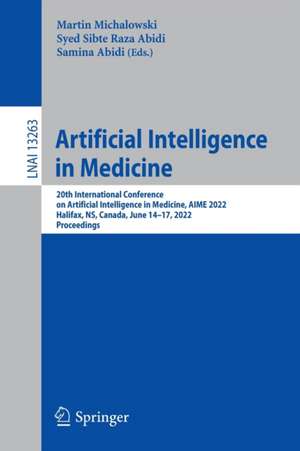Artificial Intelligence in Medicine: 20th International Conference on Artificial Intelligence in Medicine, AIME 2022, Halifax, NS, Canada, June 14–17, 2022, Proceedings: Lecture Notes in Computer Science, cartea 13263
Editat de Martin Michalowski, Syed Sibte Raza Abidi, Samina Abidien Limba Engleză Paperback – 9 iul 2022
Din seria Lecture Notes in Computer Science
- 20%
 Preț: 1061.55 lei
Preț: 1061.55 lei - 20%
 Preț: 341.95 lei
Preț: 341.95 lei - 20%
 Preț: 369.12 lei
Preț: 369.12 lei - 20%
 Preț: 645.28 lei
Preț: 645.28 lei - 20%
 Preț: 591.51 lei
Preț: 591.51 lei - 15%
 Preț: 580.46 lei
Preț: 580.46 lei -
 Preț: 410.88 lei
Preț: 410.88 lei - 20%
 Preț: 504.57 lei
Preț: 504.57 lei -
 Preț: 381.21 lei
Preț: 381.21 lei - 20%
 Preț: 340.32 lei
Preț: 340.32 lei - 20%
 Preț: 1414.79 lei
Preț: 1414.79 lei - 20%
 Preț: 538.29 lei
Preț: 538.29 lei - 20%
 Preț: 583.40 lei
Preț: 583.40 lei - 20%
 Preț: 1075.26 lei
Preț: 1075.26 lei - 20%
 Preț: 238.01 lei
Preț: 238.01 lei - 17%
 Preț: 360.19 lei
Preț: 360.19 lei - 20%
 Preț: 438.69 lei
Preț: 438.69 lei - 20%
 Preț: 1183.14 lei
Preț: 1183.14 lei - 20%
 Preț: 596.46 lei
Preț: 596.46 lei - 15%
 Preț: 438.59 lei
Preț: 438.59 lei - 20%
 Preț: 655.02 lei
Preț: 655.02 lei - 20%
 Preț: 649.49 lei
Preț: 649.49 lei - 20%
 Preț: 309.90 lei
Preț: 309.90 lei - 20%
 Preț: 337.00 lei
Preț: 337.00 lei -
 Preț: 449.57 lei
Preț: 449.57 lei - 20%
 Preț: 310.26 lei
Preț: 310.26 lei - 20%
 Preț: 1024.44 lei
Preț: 1024.44 lei - 20%
 Preț: 579.30 lei
Preț: 579.30 lei - 20%
 Preț: 763.23 lei
Preț: 763.23 lei - 20%
 Preț: 453.32 lei
Preț: 453.32 lei - 20%
 Preț: 575.48 lei
Preț: 575.48 lei - 20%
 Preț: 585.88 lei
Preț: 585.88 lei - 20%
 Preț: 326.98 lei
Preț: 326.98 lei - 20%
 Preț: 825.93 lei
Preț: 825.93 lei - 17%
 Preț: 427.22 lei
Preț: 427.22 lei - 20%
 Preț: 763.23 lei
Preț: 763.23 lei - 20%
 Preț: 350.21 lei
Preț: 350.21 lei - 20%
 Preț: 307.71 lei
Preț: 307.71 lei - 20%
 Preț: 580.93 lei
Preț: 580.93 lei - 20%
 Preț: 340.32 lei
Preț: 340.32 lei - 20%
 Preț: 343.62 lei
Preț: 343.62 lei - 20%
 Preț: 583.40 lei
Preț: 583.40 lei - 20%
 Preț: 583.40 lei
Preț: 583.40 lei -
 Preț: 389.48 lei
Preț: 389.48 lei - 20%
 Preț: 353.50 lei
Preț: 353.50 lei - 20%
 Preț: 607.39 lei
Preț: 607.39 lei
Preț: 996.07 lei
Preț vechi: 1245.09 lei
-20% Nou
Puncte Express: 1494
Preț estimativ în valută:
190.65€ • 198.28$ • 159.76£
190.65€ • 198.28$ • 159.76£
Carte tipărită la comandă
Livrare economică 14-28 martie
Preluare comenzi: 021 569.72.76
Specificații
ISBN-13: 9783031093418
ISBN-10: 3031093410
Pagini: 456
Ilustrații: XX, 456 p. 150 illus., 120 illus. in color.
Dimensiuni: 155 x 235 mm
Greutate: 0.67 kg
Ediția:1st ed. 2022
Editura: Springer International Publishing
Colecția Springer
Seriile Lecture Notes in Computer Science, Lecture Notes in Artificial Intelligence
Locul publicării:Cham, Switzerland
ISBN-10: 3031093410
Pagini: 456
Ilustrații: XX, 456 p. 150 illus., 120 illus. in color.
Dimensiuni: 155 x 235 mm
Greutate: 0.67 kg
Ediția:1st ed. 2022
Editura: Springer International Publishing
Colecția Springer
Seriile Lecture Notes in Computer Science, Lecture Notes in Artificial Intelligence
Locul publicării:Cham, Switzerland
Cuprins
Knowledge-Based Systems Explainable Decision Support Using Task Network Models in Notation.- Computerizing Lipid Management Clinical Guidelines as Interactive Task Networks.- Towards an AI planning-based pipeline for the management of multimorbid patients.- A Knowledge Graph Completion Method Applied to Literature-Based Discovery for Predicting Missing Links Targeting Cancer Drug Repurposing.- Ontological Representation of Causal Relations for a Deep Understanding of Associations between Variables in Epidemiology.- Explainable Clinical Decision Support: Towards Patient-Facing Explanations for Education and Long-term Behavior Change.- Machine Learning Assessing Knee Biomechanical Osteoarthritis Severity and Biomechanical Changes After Total Knee Arthroplasty Using Self-Organizing Maps.- NeuralSympCheck: A Symptom Checking and Disease Diagnostic Neural Model with Extracting Surrogate Decision Trees from Black-box Models to Explain the Temporal Importance of Clinical Features in Predicting Kidney Graft Survival.- Recurrence and Self-Attention vs the Transformer for Time-Series Classification: A Comparative Study.- Integrating Graph Convolutional Neural Networks and Long Short-Term Memory for Efficient Diagnosis of Autism.- Hierarchical Deep Multi-task learning for Classification of Patient Diagnoses.- TTS-GAN: A Transformer-based Time-Series Generative Adversarial Network.- Predicting Next Kidney Offer for Transplant Candidate Declining Current One.- Wrist Ultrasound Segmentation by Deep Learning.- Early Detection and Classification of Patient-Ventilator Asynchrony using Machine Learning.- On graph construction for classification of clinical trials protocols using Graph Neural Networks.- Medical Image Processing Malignant Mesothelioma Subtyping of Tissue Images via Sampling Driven Multiple Instance Prediction.- Calibrating Histopathology Image Classifiers using Label Smoothing.- InvUNET: Involuted UNET for Breast Tumor Segmentation from Ultrasound.- MRI reconstructionwith LassoNet and compressed sensing.- Predictive Modeling A 3-window-based framework for the discovery of predictive functional dependencies from clinical data.- When can I expect the mHealth user to return? Prediction meets time series with gaps.- A novel survival analysis approach to predict the need for intubation in intensive care units.- Awareness of being tested and its effect on reading behaviour.- Natural Language Processing Generating extremely short summaries from the scientific literature to support decisions in primary healthcare: a human evaluation study.- A Russian Medical Language Understanding Benchmark.- Biomedical Semantic Textual Similarity: Evaluation of Sentence Representations Enhanced With Principal Component Reduction and Word Frequency Weighting.
